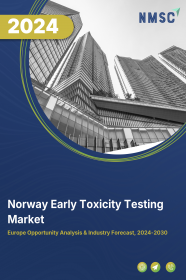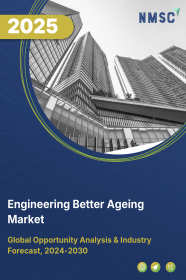
Norway Early Toxicity Testing Market by Technique (In Vivo, In Vitro, and In Silico), by Toxicity Endpoint (Genotoxicity, Dermal Toxicity, Skin Toxicity, Ocular Toxicity, Phototoxicity, and Others), by End User (Pharmaceutical Industry, Cosmetic Industry, Chemical Industry, Food Industry, and Others) – Opportunity Analysis and Industry Forecast, 2023-2030
Industry: Healthcare | Publish Date: 03-Dec-2024 | No of Pages: 93 | No. of Tables: 83 | No. of Figures: 32 | Format: PDF | Report Code : HC740
US Tariff Impact on Norway Early Toxicity Testing Market
Trump Tariffs Are Reshaping Global Business
Market Definition
Norway Early Toxicity Testing Market was valued at USD 32.19 million in 2022, and is predicted to reach USD 83.45 million by 2030, with a CAGR of 10.84% from 2023 to 2030.
Early toxicity testing serves as a crucial step in the evaluation of potential drugs, chemicals, or substances, aiming to detect and assess any harmful effects or toxicity during their initial stages of development. This assessment, usually carried out using in vitro methods or animal models, takes place before any experimentation on humans.
The primary goal of early toxicity testing is to promptly identify any safety concerns associated with a substance, enabling well-informed determinations regarding its viability for further advancement and subsequent trials.
Engaging in early toxicity testing helps reduce the potential for harmful outcomes in both human participants and animals throughout clinical trials. This not only minimizes costs but also saves time in the broader course of drug development. This complex procedure involves a wide range of analyses and tests, including evaluations of cell viability, assessments of genotoxicity, and investigations into pharmacokinetics.
The specific modalities employed are contingent on the intrinsic nature of the substance under scrutiny and its intended application.
Recognized as an indispensable phase within the drug development journey, early toxicity testing profoundly bolsters the assurance of safety and efficacy for novel drugs and other substances, before their regulatory endorsement for human utilization.
Fostering Growth in Norway's Early Toxicity Testing Market: Anchored by Pharmaceutical Innovation and Safety Imperatives
The growth of the early toxicity testing market in Norway is driven by several factors, including a focus on the research and development of new drugs and vaccines and the need for safety and efficacy in drug development.
With a well-developed pharmaceutical industry and a commitment to innovation, Norway has established itself as a leader in drug development, and early toxicity testing plays a critical role in ensuring the safety and efficacy of new drugs and vaccines.
For instance, according to a report published by the Pharmaprojects, the pharmaceutical sector in Norway conducted R&D for development of 1014 new drugs and vaccines in 2022.
Elevated Healthcare Expenditure in Norway Catalyzes Advancements in Drug Development and Testing
The increase in healthcare spending in Norway is leading to a positive-outcomes for the drug development and testing industry in the country.
With more funding available, researchers and companies are investing in creating new and improved drugs, which can lead to better health outcomes for patients.
For instance, according to the International Trade Administration, Norway is one of the top healthcare spenders in the world, with the healthcare expenditure reaching USD 43 billion or USD 7900 per citizen in 2021.
The Influence of Regulatory Limitations on the Growth of the Early Toxicity Testing Market in Norway
However, strict guidelines established by regulatory agencies like the US FDA and the EMA necessitate extensive and exacting testing for medication development and safety, which can be costly and time-consuming and impede market expansion.
Small and medium-sized businesses that may lack the means to conduct thorough testing may find it difficult and expensive to comply with these rules.
Because of this, some businesses might decide to postpone or scrap drug development initiatives, which could reduce the market for early toxicity testing services.
Furthermore, strict rules may lead to a protracted approval procedure for new pharmaceuticals, which would add to the delay in the time it takes for drugs to reach the market. This, in turn, is expected to hamper the growth of the market.
Technological Advancements in the field of Early Toxicity Testing Market in Norway
The introduction of new technologies such as in-vitro modelling using 3D cell culture is expected to provide new lucrative opportunities for the early toxicity testing market during the forecast period.
The use of 3D cell cultures can better mimic the complexity of tissues and organs, proFearly toviding more accurate and reliable results for toxicity testing. Traditional 2D cell culture models are limited in their ability to mimic the complexity of human tissues and organs, often leading to inaccurate and unreliable results in toxicity testing.
However, use of 3D cell culture models can better mimic the structural and functional complexity of tissues and organs, providing more accurate and reliable results for toxicity testing.
3D cell cultures allow the growth and interaction of multiple cell types, creating a microenvironment that more closely resembles human tissues and organs.
This can better predict the toxic effects of drugs and chemicals in the human body, reducing the risk of adverse effects in clinical trials. Hence, such factors propel the market growth.
Competitive Landscape
The Norway early toxicity testing industry includes several market players such as Inotiv Inc., Bio-Rad Laboratories Inc, Evotec A.G., Agilent Technologies Inc, Wuxi Apptec, Bruker, Perkinelmer Inc., Enzo Biochem Inc., Danaher Corporation, Eurofins Scientific SE, Charles River Laboratories International, Inc., Labcorp Drug Development., Promega Corporation, Insphero AG., and Thermo Fisher Scientific Inc.
Key Benefits
-
The Norway early toxicity testing market report provides a quantitative analysis of the current market and estimations through 2023-2030 that assist in identifying the prevailing market opportunities to capitalize on.
-
The study comprises a deep dive analysis of the market trend including the current and future trends for depicting the prevalent investment pockets in the market.
-
The information related to key drivers, restraints, and opportunities and their impact on the market is provided in the report.
-
The competitive analysis of the key players along with their market share in the Norway early toxicity testing market.
-
The SWOT analysis and Porter’s Five Forces model are elaborated in the study.
-
Value chain analysis in the market study provides a clear picture of the stakeholders’ roles.
Norway Early Toxicity Testing Market Key Segments
By Technique
-
In Vivo
-
In Vitro
-
Cell Culture
-
PCR
-
ELISA
-
Western Blotting
-
Protein Binding Assays
-
-
In Silico
By Toxicity Endpoint
-
Genotoxicity
-
Dermal Toxicity
-
Skin Toxicity
-
Ocular Toxicity
-
Phototoxicity
-
Others
By End User
-
Pharmaceutical Industry
-
Cosmetic Industry
-
Chemical Industry
-
Food Industry
-
Others
REPORT SCOPE AND SEGMENTATION:
|
Parameters |
Details |
|
Market Size in 2022 |
USD 32.19 Million |
|
Revenue Forecast in 2030 |
USD 83.45 Million |
|
Growth Rate |
CAGR of 10.84% from 2023 to 2030 |
|
Analysis Period |
2022–2030 |
|
Base Year Considered |
2022 |
|
Forecast Period |
2023–2030 |
|
Market Size Estimation |
Million (USD) |
|
Growth Factors |
Focus on research and development of new drugs and vaccines. Increase in healthcare spending. |
|
Companies Profiled |
15 |
|
Market Share |
Available for 15 companies |
|
Customization Scope |
Free customization (equivalent up to 80 working hours of analysts) after purchase. Addition or alteration to country, regional, and segment scope. |
|
Pricing and Purchase Options |
Avail customized purchase options to meet your exact research needs. |
Key Players
-
Inotiv Inc.
-
Bio-Rad Laboratories Inc
-
Evotec A.G.
-
Agilent Technologies Inc
-
Wuxi Apptec
-
Bruker
-
Perkinelmer Inc.
-
Enzo Biochem Inc.
-
Danaher Corporation
-
Eurofins Scientific SE
-
Charles River Laboratories International, Inc.
-
Labcorp Drug Development.
-
Promega Corporation
-
Insphero AG
-
Thermo Fisher Scientific Inc.

















 Speak to Our Analyst
Speak to Our Analyst




















